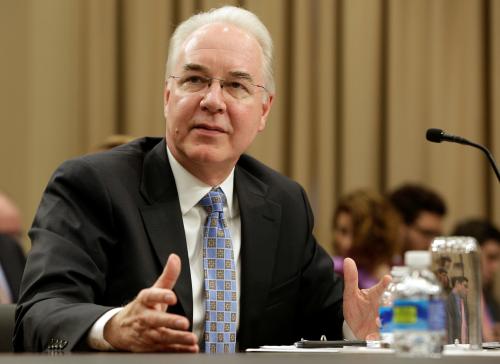This analysis is part of The Leonard D. Schaeffer Initiative for Innovation in Health Policy, which is a partnership between the Center for Health Policy at Brookings and the USC Schaeffer Center for Health Policy & Economics. The Initiative aims to inform the national health care debate with rigorous, evidence-based analysis leading to practical recommendations using the collaborative strengths of USC and Brookings.
On April 13, 2017, the Centers for Medicare and Medicaid Services (CMS) released its first set of regulations affecting the health insurance exchanges created by the Affordable Care Act (ACA) under the Trump administration. In the regulations, CMS indicated that the rule “finalizes changes that will help stabilize the individual and small group [health insurance] markets.”
While it is unclear whether the changes included in the rule will have a small positive or small negative impact on market stability, it is clear that the impact pales in comparison to the significant instability caused by the lack of commitment from the administration (or Congress) to fund the ACA’s cost-sharing reduction subsidies or to enforce the individual mandate.
The ACA requires insurers to cover cost-sharing subsidies to help low-income exchange enrollees pay out-of-pocket costs like deductibles and copays, with the understanding that they will be reimbursed by the federal government. However, these payments to insurers are currently subject to legal challenges, and the administration has been unclear regarding whether it intends to continue to fund them (or ask Congress to do so legislatively). Similarly, it is highly unclear whether the administration plans to enforce the law’s individual mandate, or whether they will actively support the marketing of policies during open enrollment.
In contrast to the indicated intention to promote market stability with the recent rule, this lack of clarity surrounding the future of the ACA’s cost-sharing subsidies and individual mandate instead injects a considerable degree of uncertainty regarding the short and long-term future of the exchanges.
Not surprisingly, then, insurers have taken notice of the lack of clarity in the market. Last week, eight major health care organizations representing insurers, providers, and employers jointly issued letters to the administration and Congress stating that “the most critical action to help stabilize the individual market for 2017 and 2018 is to remove uncertainty about continued funding for cost-sharing reductions.” Marilyn Tavenner, President and CEO of America’s Health Insurance Plans (AHIP) —an advocacy and trade group that represents health insurers—has stated that, in the absence of such clarity, “many plans will likely drop out of the market.”
Cost-sharing subsidies in jeopardy?
Distinct from the subsidies that help individuals pay their premiums, the ACA’s cost-sharing reduction subsidies help individuals with incomes between 100 and 250 percent of the Federal Poverty Level pay deductibles and co-payments that are charged at the point of care. Nearly three in five individuals covered on the exchanges are eligible for these subsidies, and the CBO has projected that the subsidies would amount to $9 billion in 2017.
Legally, insurers are obligated to reduce eligible individuals’ cost-sharing, with the expectation that they will, in turn, be reimbursed by the federal government. These reimbursements from the federal government have been operating as a mandatory program to date (therefore not requiring annual appropriations), but there is a legal challenge underway positing that the ACA statute does not provide authority to fund these reimbursements outside of the appropriations process. The House of Representatives sued the Obama administration and, in May 2016, the district court of the District of Columbia ruled that these payments to insurers were unconstitutional. However, recognizing the havoc that would ensue if the insurer payments were abruptly stopped, the court allowed the payments to continue while the Obama administration appealed the decision.
Upon taking office, the Trump administration inherited the lawsuit and, together with the House of Representatives, asked the court to delay the appeal while they attempted to implement new health care reform legislation, which could make the case a non-issue. However, with the failure of the American Health Care Act (AHCA) to gain approval in the House of Representatives, the future of these payments has come front and center. The administration has sent mixed signals on their intentions regarding these payments, though most recently, President Trump has indicated that he may withhold the payments as an attempted means to force Democrats to negotiate on health care reform.
As noted above, billions of dollars are at stake; the Kaiser Family Foundation estimated that insurers would need to increase premiums for silver plans, the most common plan type in the individual market, by 19 percent to compensate for the lost revenues if the federal government reneged on these payments. If the Administration wants to continue the payments, the legal issue also could be avoided by asking Congress to appropriate the funds.
Moreover, if the administration reneges upon the cost-sharing subsidies after insurers set rates for 2018, insurers would experience very substantial losses (although it is likely they would recoup the unpaid CSR payments). As a result, unless the administration makes clear its intention to make these payments, insurers will have to request higher premiums to reflect this uncertainty and many will instead likely choose not to participate in the ACA marketplaces at all.
The Exchanges Need Insurers, and Insurers Need Clarity on the Rules
The ACA’s exchanges rely on private health insurance companies to participate in selling policies to individuals in order to make the market function. There is no public option or fallback plan, unlike what was provided for in the legislation creating Medicare Part D. It is entirely reliant on private plans. Private companies cannot be expected to participate in a market where the rules and regulations are not made clear in advance and where there is no faith that the government will uphold its end of the bargain.
While managing risk is a key part of insurers’ businesses, this does not apply to all risks. Insurers are set up to pool risks, such as covering a population, some of whom will turn out to have high medical expenses and others will not. More challenging for them is predicting changes in aggregate health spending a year or two into the future. But the most extreme challenges come from unfamiliarity with the risk profile of those who are insured and political uncertainty, which might change the rules after the products have been filed and the rates set for the year.
Insurers cannot function in a world of heightened political uncertainty. They need clarity on the rules of the markets in which they are expected to operate.
Insurers cannot function in a world of heightened political uncertainty. They need clarity on the rules of the markets in which they are expected to operate. Moreover, timing is of the essence. Beginning in May and June, insurers must submit regulatory filings regarding the plans they intend to offer in 2018, including the premiums they will charge.
By exposing insurers to this political uncertainty, the harm that results will impact both those individuals who seek to be insured and the government, which provides tax credits to make the coverage affordable. Insurers have only two options in this situation: set premiums much higher than would otherwise be the case or drop out of the market completely. If insurers raise premiums, federal spending will increase on the premium subsidies for which 84% of exchange enrollees qualify, and the millions of Americans who do not qualify for these premium subsidies, on- and off-exchange, will face much higher costs. If insurers exit the market, many individuals could be left with no options; in 2017, 21% of exchange enrollees live in an area where only one insurer participates in the exchange. For the sake of society broadly, insurers need clarity on the rules of the market, and they need it now.
Changes Made After Insurers File Rates Have Serious Financial Consequences
Insurers need not look very far back in history for a reminder that policy changes made after rates have been filed have serious financial consequences.
Beginning in 2014, the ACA prohibited insurers from charging sicker people higher premiums in the individual market. This represented a considerable departure from the rules of the pre-ACA individual market, where most states allowed insurers to charge higher premiums to sicker individuals or deny them coverage entirely.
In the spring of 2013, when insurers filed their rates for the new ACA plans for coverage beginning in January 2014, they did so under the expectation, as laid out in the ACA, that any individual market policy sold under pre-ACA regulations would be terminated.[1] Individuals covered in the pre-ACA individual market tended to be healthier than the people who were expected to enroll in ACA plans since insurers were no longer allowed to deny coverage or charge higher premiums for sicker individuals. Insurers had every reason to believe that this healthy population would become part of the pool of those with ACA-compliant plans and priced their plans according to this expectation.
However, when individuals with pre-ACA coverage that was not compliant with ACA rules began receiving plan termination letters, critics exclaimed that President Obama had lied when he promised individuals that “if they liked their plan, they could keep it.” Amid considerable pushback, on November 14, 2013, CMS gave states the option to allow health insurers to renew these non-ACA-compliant policies; 39 states allowed insurers to do so. However, insurers were not allowed to increase their premiums for 2014 to adjust for new expectations about the risk profile of who would enroll in ACA-compliant policies.
These state decisions had significant financial consequences for insurers. One analysis of insurer experience in the 2014 individual market found that insurer financial performance (measured by lower medical loss ratios, or spending a lower fraction of earned premiums on medical claims) was negatively correlated with the proportion of the individual market enrolled in non-compliant plans. Another recent study found that insurers located in states that terminated non-compliant plans had revenues (in excess of claim costs) that were considerably higher, on average, than insurers in states that allowed individuals to remain in non-compliant plans.
That is, insurers that were subject to rule changes affecting the risk pool after premiums had been set did notably worse, financially, than those where the rules were implemented as expected. Insurers know this, and requiring them to file rates now, while fostering uncertainty around what the rules will look like once those policies have been sold, does not make for an attractive business proposition.
Clarity and Certainty Promotes Stability
The exchanges have come a long way in just four years. Despite many claims of death spirals, evidence suggests that the exchanges are actually evolving into viable markets. One recent study found that the exchanges have exhibited signs of insurer entry and exit that would be expected in a newly-created market, where different types of firms are assessing how (and whether) to participate, while another indicated that insurer margins have considerably improved.
This progress will be for naught if the Administration and Congress continue to foster such intense uncertainty around the rules of this market. There are viable options to move forward. The Administration could clearly lay out its intentions to enforce the individual mandate and pay cost-sharing subsidies, or Congress could appropriate the money to fund the cost-sharing reduction subsidies. But toying with such funding as a bargaining chip is not productive and will inject a level of uncertainty that is too high for insurers to participate. Health insurance coverage for millions of individuals is at stake.
[1] The ACA allowed individuals to remain in grandfathered plans that existed as of March 23, 2010 and were not significantly changed.
The authors did not receive financial support from any firm or person for this article or from any firm or person with a financial or political interest in this article. They are currently not an officer, director, or board member of any organization with an interest in this article.











Commentary
To promote stability in health insurance exchanges, end the uncertainty around cost-sharing and other rules
April 20, 2017